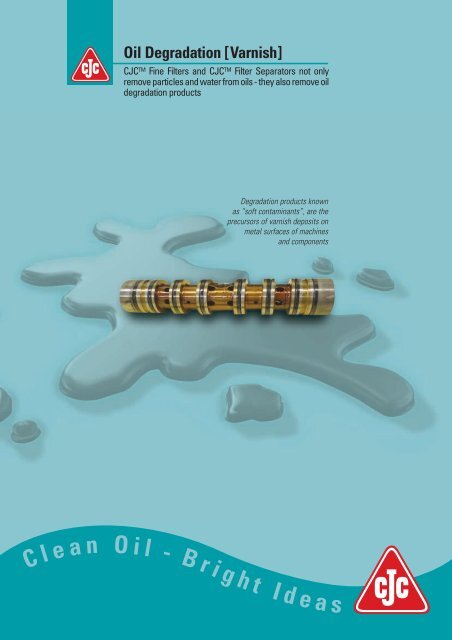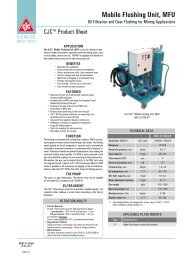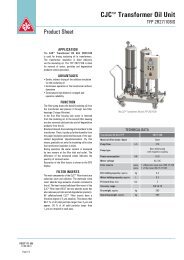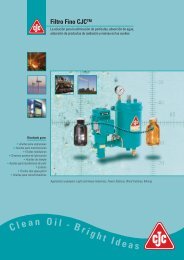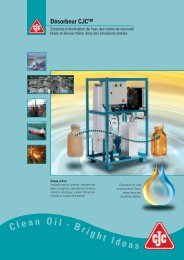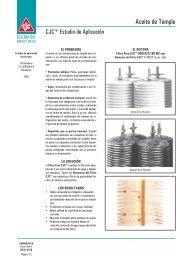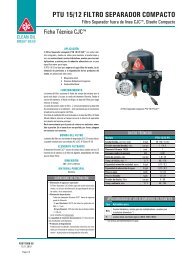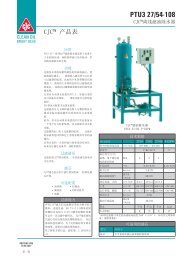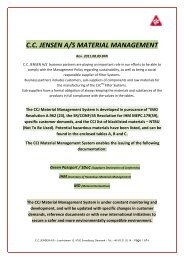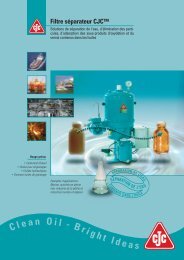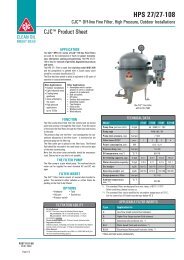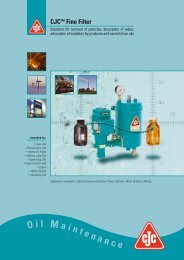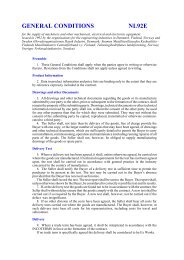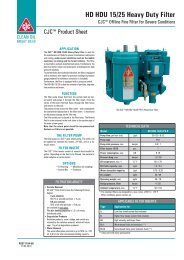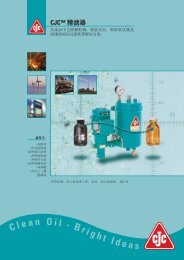Oil Degradation (Varnish) - Cjc.dk
Oil Degradation (Varnish) - Cjc.dk
Oil Degradation (Varnish) - Cjc.dk
Create successful ePaper yourself
Turn your PDF publications into a flip-book with our unique Google optimized e-Paper software.
<strong>Oil</strong> <strong>Degradation</strong> [<strong>Varnish</strong>]<br />
CJC TM Fine Filters and CJC TM Filter Separators not only<br />
remove particles and water from oils - they also remove oil<br />
degradation products<br />
<strong>Degradation</strong> products known<br />
as “soft contaminants”, are the<br />
precursors of varnish deposits on<br />
metal surfaces of machines<br />
and components<br />
C l e a n<br />
O i<br />
l -<br />
B r<br />
i g h t<br />
I d e a s
Introduction<br />
[<strong>Varnish</strong>]<br />
“A thin, insoluble, nonwipeable film<br />
deposit occurring on interior parts,<br />
resulting from the degradation and<br />
polymerization of oil”<br />
(source: Noria)<br />
Any lubricant in service or in storage will degrate over time, depending on<br />
the type of oil, the operation conditions and the environment. When the oil<br />
deteriorates, it will change its composition and functional properties. During<br />
the degrading process, a number of unwanted products are formed, which<br />
can lead to varnish deposits, all of which will result in costly consequences<br />
for machinery, such as corrosion, sticking valves, varnish, etc.<br />
In this brochure you can read about the consequences of oil deteriorating,<br />
as well as finding solutions on how to remove and monitor degradation<br />
products.<br />
HDU 15/25 PV HDU 27/27 P PTU 15/25 PV PTU2 27-27 PV<br />
CJC Fine Filters and CJC Filter Separators<br />
C<br />
l e a n<br />
O i<br />
l -<br />
B r i g h t I d e a s<br />
2<br />
Baltzer Grafik • <strong>Oil</strong> <strong>Degradation</strong> • UK • 03.2010
Removal of <strong>Degradation</strong><br />
Products from <strong>Oil</strong><br />
<strong>Oil</strong> degrading is a common problem<br />
in both lubrication and hydraulic systems<br />
3
1<br />
Process<br />
The Problem<br />
<strong>Oil</strong> degrading is a common problem both in lubrication<br />
and hydraulic systems. The main causes of this<br />
are typically oxidation (oxygen), hydrolysis (water)<br />
and thermal degradation (high temperature). In many<br />
cases it is a combination of all three.<br />
Oxidation Hydrolysis Thermal degradation<br />
Reagent<br />
Oxygen<br />
Water<br />
Heat<br />
Process<br />
catalysed<br />
by:<br />
Temperature / Water<br />
Oxygen / Temperature<br />
Water / Oxygen<br />
Transition metals (wear particles, Cu, Fe, Al)<br />
Contaminants (contamination in general, oxidation products)<br />
Pressure<br />
The degradation<br />
process is<br />
catalysed by:<br />
Oxygen<br />
Water<br />
High<br />
temperature<br />
Oxidation<br />
Oxidation<br />
Oxidation is the breakdown of the oil with oxygen as reagent. The oxidation<br />
process involves a series of reactions forming acid compounds and polymerized<br />
compounds. Oxidation leads to insoluble products (sludge) that may<br />
precipitate as a thin film, forming lacquers or varnish deposits on hot or<br />
cold metal surfaces.<br />
Hydrolysis<br />
Hydrolysis<br />
Hydrolysis is the breakdown of the oil with water as reagent. Like oxidation,<br />
hydrolysis can result in acid compounds and varnish. Oxidation products<br />
such as: hydroperoxides, carboxylic acids, ketones, aldehydes and<br />
others, usually possess increased solubility in water and therefore often<br />
accelerate the hydrolysis process.<br />
Thermal<br />
Thermal <strong>Degradation</strong><br />
Thermal degradation is the breakdown of the oil activated by heat (high<br />
temperature). Typically thermal degradation occurs in the hot spots of the<br />
system. It can also result in polymers and insoluble compounds, which lead<br />
to varnish formation as occurs in the oxidation process.<br />
<strong>Degradation</strong><br />
Wear<br />
particles<br />
Example of varnish<br />
formation on<br />
steering gear<br />
Contaminants<br />
4
<strong>Oil</strong> <strong>Degradation</strong> and<br />
Consequences<br />
<strong>Oil</strong> <strong>Degradation</strong> will Result in:<br />
Formation of acidic compounds:<br />
Acid promotes corrosion, for example pitting. This leads to increased wear<br />
in the internal surfaces of the machine.<br />
Increase in oil viscosity:<br />
The oil´s resistance to flow will increase, which will result in friction, wear<br />
and loss in efficiency of equipment.<br />
Decreased additive performance:<br />
Additives (antioxidants and detergents) also react with the degrading products.<br />
The result is that the additives lose their effect - and instead accelerate the<br />
deterioration process.<br />
<strong>Varnish</strong> formation:<br />
<strong>Varnish</strong> deposits are “sticky” and will trap hard contaminants, creating a<br />
“sandpaper surface”. This “sandpaper” causes accelerated wear in components.<br />
In addition, varnish can result in filters and valves blocking, and<br />
orifices clogging. Furthermore varnish acts as an insulator, reducing the<br />
effect of the heat exchangers, resulting in higher temperatures and accelerated<br />
reaction speeds.<br />
Examples of varnish:<br />
<strong>Oil</strong> reservoir<br />
(Plastic<br />
Moulding<br />
Machine)<br />
Machine<br />
components<br />
Once the varnish deposits have formed on the metal surfaces, it is very difficult<br />
to dissolve them.<br />
Consequences of the <strong>Oil</strong> Degrading:<br />
Shorter oil life<br />
An increase in the level of oil degradation<br />
<strong>Degradation</strong> products act as a catalyst<br />
A reduction of additive performance<br />
Reduced oil performance<br />
Loss of lubricity<br />
Valve failure<br />
Restricted oil flow<br />
Reduced productivity<br />
Monday morning problems: slow start-ups<br />
Increased downtime<br />
Reduced machine performance<br />
Steering<br />
gear<br />
<strong>Varnish</strong> on<br />
gas turbine<br />
<strong>Varnish</strong><br />
on bolts<br />
Higher energy consumption<br />
Friction and wear<br />
Increased maintenance costs<br />
Increased filter change frequency<br />
Increased wear of components<br />
Acidic corrosion in metallic components<br />
Component failures<br />
Cleaning of the oxidation deposits<br />
Environmental pollution consequences<br />
Greater disposal costs of oil and filter changes<br />
Leakages<br />
5
2<br />
The Solution<br />
Removal of degradation products before they have<br />
time to react further and form insoluble sludge and<br />
varnish deposits<br />
<strong>Oil</strong> degradation products cannot be removed with conventional mechanical<br />
filters because they are submicron particles. It is a fluid in a fluid - like when<br />
sugar is dissolved in coffee.<br />
These degradation products can be removed by CJC TM Fine Filters and<br />
CJC TM Filter Separators through a combination of adsorption and absorption<br />
processes.<br />
Adsorption is the physical or chemical binding of molecules to a surface (like<br />
getting a cake thrown into your face). In contrast with absorption, in which<br />
molecules are absorbed into the media. See illustrations.<br />
CJC TM Filter Inserts, made of cellulose fibres, have a high surface area and<br />
can be effective as adsorbents and absorbents. In addition, due to their<br />
chemical nature, they are highly suited to pick-up oxygenated organic<br />
molecules, such as oil degrading products.<br />
Absorption<br />
can be illustrated by this<br />
drawing: The chemical substances<br />
(the cake) is absorbed<br />
by the media (the man)<br />
Absorption<br />
Adsorption<br />
can be illustrated by this<br />
drawing: The chemical substances<br />
(the cake) is binding<br />
to a surface (the man)<br />
Adsorption<br />
The CJC Solution<br />
Filter Insert consisting of<br />
cellulose fibres treating the oil<br />
This illustration shows the contaminated<br />
oil approaching the cellulose fibres<br />
in an almost new Filter Insert<br />
Filter Insert near saturation<br />
This illustration shows that the<br />
Filter Insert is still producing clean oil<br />
even though the cellulose fibres are<br />
nearly saturated<br />
Feed<br />
<strong>Oil</strong> degradation particles<br />
Fibres<br />
Purified oil<br />
6
Absorption and Adsorption<br />
by CJC Filter Inserts<br />
Cross-section of a cellulose fibre<br />
Each cellulose fibre consists of<br />
millions of cellulose molecules.<br />
Each strand of cellulose<br />
molecules has a diameter<br />
of 10 -6 cm (0.000001cm)<br />
<strong>Degradation</strong><br />
products are<br />
absorbed and<br />
adsorbed into<br />
the cellulose<br />
material<br />
Film diffusion:<br />
Transport from the oil to the<br />
boundary of the adsorbent<br />
(fibre). The resistance is<br />
pictured as a fictitious film<br />
Macropore diffusion:<br />
Transport within the adsorbent<br />
(fibre). This can be viewed<br />
amongst the subfibres<br />
Micropore diffusion:<br />
Transport from the pore fluid<br />
to the adsorption sites at the<br />
adsorbent surfaces. This can<br />
be viewed amongst the<br />
molecules<br />
Feed<br />
<strong>Oil</strong> degradation particles<br />
Fibres<br />
Purified oil<br />
CJC Filter Inserts Remove Contaminants<br />
of any Kind and Size<br />
Hard contaminants: Wear particles, debris, dirt<br />
Soft contaminants: <strong>Varnish</strong> / oxidation<br />
Water<br />
Before<br />
Millipore<br />
membrane<br />
Sample taken<br />
before offline<br />
filtration<br />
After<br />
Millipore<br />
membrane<br />
Sample taken<br />
after offline<br />
filtration<br />
CJC<br />
Filter Insert<br />
before use<br />
CJC<br />
Filter Insert<br />
after use<br />
7
3<br />
The Result<br />
CJC <strong>Oil</strong> Filtration will maintain both oil and system<br />
cleanliness<br />
Longer oil life<br />
Increased oil performance and lower energy consumption<br />
Increased productivity<br />
Less maintenance<br />
Environmentally friendly<br />
An <strong>Oil</strong> System Free<br />
from <strong>Varnish</strong> Deposits<br />
Problem<br />
8<br />
Solution
Removal of <strong>Varnish</strong> Deposits<br />
from Metal Surfaces<br />
By using CJC TM Offline Filters, the amount of varnish deposits on metal<br />
surfaces will be reduced. It is explained by the adsorption equilibrium<br />
behaviour.<br />
There is an equilibrium between the two phases, i.e. the fluid (oil) and varnish<br />
on the surfaces. When the oil becomes cleaner, the deposits from the<br />
system become unstable because the concentration of oil degradation products<br />
in the oil has decreased. This will result in a decrease of the amount<br />
of adsorbed substance. In other words, this means that the oil degradation<br />
products on the metal surfaces are released. The oil functions as a system<br />
cleaner.<br />
Summary<br />
Problem:<br />
The oil is contaminated by<br />
hard contaminants, water<br />
and soft contaminants,<br />
which lead to<br />
varnish deposits<br />
Solution:<br />
Removal of the contaminants<br />
by CJC TM Offline<br />
Filters before they will<br />
form sludge and varnish<br />
deposits<br />
Result:<br />
Lower levels of contamination,<br />
which will prevent<br />
deposit formation.<br />
Futhermore the deposits,<br />
once formed, will be reduced<br />
by using CJC TM <strong>Oil</strong><br />
Filtration<br />
Result<br />
Maintenance:<br />
By CJC TM <strong>Oil</strong> Filtration<br />
you will maintain both oil<br />
and system cleanliness<br />
Maintenance<br />
9
How to Monitor <strong>Oil</strong> <strong>Degradation</strong><br />
Soft contaminants are compounds of molecular sizes,<br />
which cannot be measured by conventional particle<br />
counting methods<br />
There are several methods that measure different aspects of the deteriorating<br />
oil. These methods generally measure the amount of certain degradation<br />
products from oil or the amount of additives in the oil.<br />
The Following are Indications of <strong>Oil</strong> Deteriorating:<br />
Dark colour<br />
Sour and putrid odour<br />
Increase in oil viscosity<br />
Increase in<br />
oil viscosity<br />
Sour and putrid<br />
odour indicates oil<br />
degradation<br />
Indications of <strong>Oil</strong><br />
Deterioration<br />
Dark colour<br />
10
Methods to Monitor<br />
<strong>Oil</strong> <strong>Degradation</strong><br />
Methods to Monitor the Level of <strong>Degradation</strong> in the <strong>Oil</strong>:<br />
Ultracentrifuge<br />
test<br />
Colourimetric/<br />
millipore<br />
membrane<br />
analysis<br />
Ultracentrifuge Test:<br />
This test uses the gravitatory forces<br />
to extract and settle the contaminants<br />
of the oil. The sediments<br />
are compared with a sedimentation<br />
rating system to determine<br />
the degradation of the oil.<br />
Colourimetric/Millipore<br />
Membrane Analysis:<br />
This analysis is an indication that<br />
the oil contains degradation products.<br />
The varnish is captured in<br />
the white millipore membrane<br />
(0.45 micron cellulose membrane),<br />
and shows as a yellow, brownish<br />
or dark colour depending on the<br />
amount of varnish present in the<br />
oil. A microscopic magnification<br />
shows if the colour comes from<br />
varnish or hard particles.<br />
Infrared Spectroscopy:<br />
(FTIR Analysis - Fourier Transformation<br />
Infrared Spectroscopy)<br />
This analysis is based on the principles<br />
of molecular spectroscopy. It<br />
can verify the level of oil degradation<br />
by the identification of the<br />
functional groups (e.g. ketones,<br />
carboxylic acids) in molecules.<br />
QSA Test:<br />
This method identifies the varnish<br />
potential rating, and is based on<br />
colorimetric analysis.<br />
By comparing the result to a large<br />
database of QSA tests, a 1 to 100<br />
severity rating scale indicates the<br />
propensity of the lubricant to form<br />
sludge and varnish<br />
Infrared<br />
spectroscopy<br />
QSA<br />
test<br />
Gravimetric<br />
analysis<br />
Gravimetric Analysis:<br />
This analysis can determine the<br />
level of oil degradation by measuring<br />
the weight of residual<br />
components.<br />
Viscosity Test:<br />
This test measures the oil resistance<br />
to flow. It can be used as an<br />
indicator of oil degradation.<br />
Viscosity<br />
test<br />
RULER<br />
test<br />
RULER Test<br />
Indicates the amount of anti-oxidants<br />
(oil additives). When the additives<br />
get depleted due to incipient<br />
degradation of the oil the RULER<br />
number decreases. This effect is<br />
evident before varnish starts precipitating,<br />
which makes the test<br />
proactive.<br />
TAN (Total Acid Number):<br />
This analysis measures the level of<br />
acid compounds. It can also be<br />
used as an indicator of oil degradation,<br />
since acid is a product of<br />
degradation.<br />
TAN<br />
analysis<br />
Methods to Monitor the Consumption of Additives:<br />
FTIR Analysis<br />
(Fourier Transformation Infrared Spectroscopy)<br />
It can monitor the additive depletion.<br />
RULER Test (Remaining Useful Life Evaluation Routine)<br />
It measures the remaining antioxidants by voltammetric analysis.<br />
RBOT Test (Rotating Bomb Oxidation Test)<br />
It measures the oil’s resistence to oxidation under prescribed conditions.<br />
11
C.C.JENSEN all over the World<br />
The CJC Offline Filters are distributed by our own international<br />
sales organisation and designated distributors<br />
Manufacturer & Headquarters<br />
C.C.JENSEN A/S<br />
Denmark • Løvholmen 13 • DK 5700 Svendborg<br />
Tel. +45 6321 2014 • Fax: +45 6222 4615<br />
filter@cjc.<strong>dk</strong> • www.cjc.<strong>dk</strong><br />
Benelux<br />
C.C.JENSEN Benelux B.V.<br />
Tel.: +31 182 37 90 29<br />
ccjensen.nl@cjc.<strong>dk</strong><br />
www.ccjensen.nl<br />
France<br />
C.C.JENSEN France<br />
Tel: +33 3 59 56 16 58<br />
ccjensen.fr@cjc.<strong>dk</strong><br />
www.ccjensen.fr<br />
Italy<br />
KARBERG & HENNEMANN srl<br />
Tel: +39 059 29 29 498<br />
info@cjc.it<br />
www.cjc.it<br />
United Kingdom<br />
C.C.JENSEN LTD.<br />
Tel.: +44 1 388 420 721<br />
filtration@cjcuk.co.uk<br />
www.ccjensen.co.uk<br />
Chile<br />
C.C.JENSEN S.L. Limitada<br />
Tel.: +56 2 739 2910<br />
ccjensen.cl@cjc.<strong>dk</strong><br />
www.ccjensen.cl<br />
China<br />
C.C.JENSEN A/S China<br />
Tel: +86 10 6436 4838<br />
ccjensen.cn@cjc.<strong>dk</strong><br />
www.ccjensen.cn<br />
Denmark<br />
C.C.JENSEN Danmark<br />
Tel: +45 72 28 22 22<br />
ccjensen.<strong>dk</strong>@cjc.<strong>dk</strong><br />
www.cjc.<strong>dk</strong><br />
Germany<br />
KARBERG & HENNEMANN<br />
GmbH & Co. KG<br />
Tel: +49 (0)40 855 04 79 0<br />
kontakt@cjc.de<br />
www.cjc.de<br />
Greece<br />
C.C.JENSEN Greece LTD.<br />
Tel.: +30 210 42 81 260<br />
ccjensen.gr@cjc.<strong>dk</strong><br />
www.ccjensen.gr<br />
Ireland<br />
C.C.JENSEN Ireland<br />
Tel.: +353 61 374 943<br />
ccjensen.ie@cjc.<strong>dk</strong><br />
www.ccjensen.ie<br />
Poland<br />
C.C.JENSEN Polska Sp. z o.o.<br />
Tel.: +48 22 648 83 43<br />
ccjensen@ccjensen.com.pl<br />
www.ccjensen.pl<br />
Spain<br />
C.C.JENSEN Ibérica, S. L.<br />
Tel.: +34 93 590 63 31<br />
ccjensen.es@cjc.<strong>dk</strong><br />
www.cjc.<strong>dk</strong><br />
United Arab Emirates<br />
C.C.JENSEN Middle East<br />
Tel: +971 4 447 2886<br />
ccjensen.uae@cjc.<strong>dk</strong><br />
www.cjc.ae<br />
USA<br />
C.C.JENSEN INC.<br />
Tel.: +1 770 692 6001<br />
ccjensen@ccjensen.com<br />
www.ccjensen.com<br />
C<br />
l e a n<br />
O i<br />
Your Local CJC TM Distributor<br />
l -<br />
B r i g h t I d e a s<br />
We are represented<br />
all over the world by<br />
distributors.<br />
Find your nearest<br />
distributor on our<br />
website: www.cjc.<strong>dk</strong><br />
- or give us a call.


